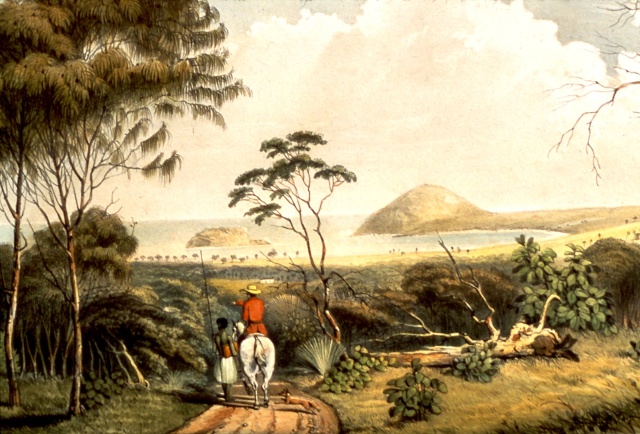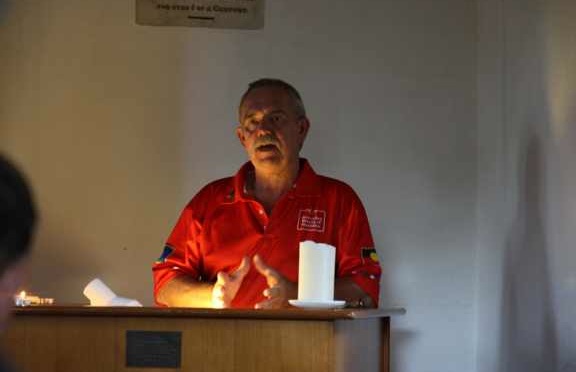The Peramangk were the mysterious dwellers of the Mount Lofty Ranges prior to the white occupation of South Australia in 1836. Twenty years after the Mount Barker region was settled, they had all but disappeared.
It is difficult to make an accurate assessment of the original number of Aboriginal occupants who dwelt in what we now call the Mount Lofty Ranges. For example, two separate estimates of the numbers of Kaurna on the Adelaide Plains at settlement, suggest as few as three hundred, and as many as seven hundred when the colonists arrived in 1836. Obviously it would be more difficult, given the many forests and a more rugged terrain in the hills, to make an accurate assessment of the Peramangk numbers.
 Peramangk Man
Peramangk ManA further complication was the spread of smallpox, even before South Australia was formally settled in 1836. Having established a foothold in the colony of NSW in 1789, smallpox gradually worked its way into southern Australia, possibly via whalers and sealers who used Kangaroo Island as a base as early as 1810. Smallpox is also said to have come down the major river, which we now know as the Murray, perhaps through native people who had come into contact with smallpox when upstream, and had brought it south. The traditional numbers were therefore depleted before settlement, and it is unlikely any serious attempt was made to obtain accurate numbers in a new, rugged land, where survival alone was quite enough to cope with. Having no genetic resistance to smallpox, the impact on the traditional inhabitants was deadly, as were diseases of lesser concern to Europeans, such as measles. An early account of the Peramangk people puts the greater number of them in the Mount Barker region, and they were often referred to as the ‘Mount Barker Tribe.’ One description tells of somewhere near 300 camped at the base of Mount Barker Summit, and another 300 camped along the Larataringa Creek and the springs to the south of the mount. It would seem a reasonable guess to put a figure of around seven hundred to a thousand Peramangk in the region considered their domain, based on these estimates.
One must also bear in mind that gatherings of this number would be rare, and would undoubtedly have been the result of important ceremonial occasions. Initiation, ‘increase’ ceremonies to ensure the abundance of food and the cycle of the seasons, ‘sorry’ business, (funeral rites) and the practice of allocating future wives to young men, are but a few of the ceremonies practised throughout the vast territories of Australia, and in the remote regions, still undertaken to this very day. In ‘normal’ times, groups of up to perhaps thirty, comprised of an elder, his wives, and his offspring, including in-laws, would roam the land, according to where the appropriate food, shelter or water was to be found.
 Mt Barker Summit (Womma Mu Kurta – The Mountain on the Plain)
Mt Barker Summit (Womma Mu Kurta – The Mountain on the Plain)
Despite the reference to the Peramangk as the ‘Mount Barker Tribe’ their terrain was much more wide-ranging, and in general their territory was considered to be the region we now refer to as the Mount Lofty Ranges, extending from the foothills above the Adelaide plains, Mount Barker to the east, Myponga to the south, and northward to Angaston. Both the Kaurna of the plains, and the Ngerringerri of the lakes and southern river regions feared the Peramangk, who were said to be possessed of magical powers and sorcery. Prior to colinisation, there were three explorations of South Australia directly relevant to the fate of the Peramangk, and following articles will provide an account of those expeditions. Particular attention will be paid to early and first contact by these expeditions as an insight into attitudes and consequences of relationship to the indigenous peoples in general, as there is little documentation of first contact specifically with the Peramangk.
Mathew Flinders
Captain Matthew Flinders of the Investigator in 1802, and coincidentally Captain Nicholas Baudin on the Geographe the same year, commanded the first expeditions to undertake comprehensive exploration of the southern coast. Baudin’s explorations were predominately of a scientific nature, with a full compliment of botanists, artists, and other scientific people on board. He naturally created charts and named places as he went. Flinder’s brief was to circumnavigate the continent, mapping comprehensively, and therefore the documentation of his journey was skewed to this end. When western bound Flinders, (an Englishman) and the eastern sailing Frenchman Baudin met in the bay they called Encounter in April of that year, they exchanged charts and wined and dined together, although unbeknown to them, their countries were at war. They also in part accepted the place names each had given the coast during their travels, thus explaining the mixture of French and English names which dot the coast. The Fleurieu Peninsula is a prominent example of features named by Baudin. The Flinder’s Ranges, Kangaroo Island and Mount Lofty are among the most prominent and well known English names which Flinders conferred on the landscape.  Encounter Bay
Encounter Bay
Incredibly, both of these renowned explorers missed the mouth of Australia’s most important river, not far from their historic meeting. In their defence, the Murray meets the ocean via a large lake before meandering around islands in diverse channels, and a long narrow body of water stretches some eighty kilometres to the south-east, sheltered from the ocean by large sand dunes. This body of water is called the Coorong. Sand dunes on both sides of the modest volume of water which constitutes the Murray mouth, as well as a possible sea mist, coupled with the distance from the shore at which the ships would have been sailing, would all have contributed to the oversight by both Commanders.
Some of the earliest sketches of Aboriginal people can be found in Baudin’s collection, and his party’s contact with Aboriginal people was comprehensive, although not so much in South Australia, where the rugged coastline made anchoring difficult. It was established that Kangaroo Island was devoid of Aboriginal people, although subsequent archaeological work has established that it had previously been inhabited approximately 10,000 years ago, when the island was still part of the mainland. No reliable explanation has been proffered as to why such a large and productive island did not have people in numbers living there at the time of settlement. There were, however, a rag-tag band of sealers of various nationality, including Americans, escaped convicts, and the Aboriginal women they had gathered from where ever they could. This included Tasmanian women, and also women from the mainland. These women were taken by force, resulting in a tragic retaliation in later years. This motley crew would have been living on Kangaroo Island when the next important exploration of Southern Australia took place in 1829-30, although Captain Charles Sturt was probably unaware of their presence. For some detail of Sturt’s journey, click here. A little over a year later, the death of Captain Collet Barker at the mouth of the Murray River added a tragic chapter to Aboriginal/European first contact.









